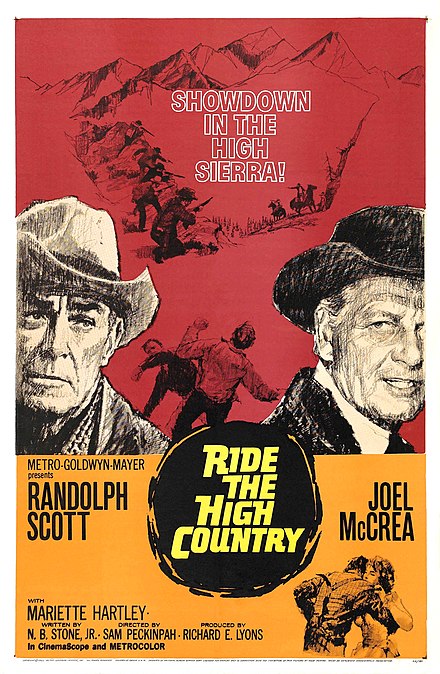Director Sam Peckinpah’s second feature, Ride the High Country, is both a swan song to the codes of the Old West and a celebration of two vet actors, Randolph Scott and Joel McCrea, who have contributed immeasurably to the genre but had never been acknowledged properly.
| Ride the High Country | |
|---|---|

Theatrical release poster
|
|
The script is credited solely to TV writer N. B. Stone, Jr., but major contributions were made by Stone’s colleague, William S. Roberts, and Peckinpah himself.
Set at the turn of the century, the film opens in the town of Hornitos, which is in the midst of a celebration. Steve Judd (McCrea), an aging former lawman, thinks that the crowd cheers for him, but he is reminded of the changing times when a car nearly runs him over.
Steve serves as an escort of a gold shipment from the mining town of Coarse Gold back to a bank in Hornitos, but the banker is taken aback by his age. In fact, Steve reads his contract in the bathroom so that the banker won’t see that he needs spectacles.
After getting the job, he hires help for the trip, beginning with Gil Westrum (Scott), a fellow former lawman who has survived by dressing up as the “Oregon Kid,” selling out his former heroic image.
Steve hires Gil and his young sidekick Heck Longtree (Starr), but Gil plans to steal the gold.
Spoiler Alert: Last Scene
When they reach Elsa’s farm, the Hammond brothers are waiting for them, having already killed her father. A gunfight breaks out and both Judd and Heck are wounded. Gil comes riding in to help his old friend, and together they insult and challenge the brothers to a shootout, in which all three siblings die and Judd is mortally wounded. He tells his old friend, “I don’t want them to see this. I’ll go it alone.” When Gil pledges to take care of everything just like he would have, Judd says, “Hell, I know that. I always did. You just forgot it for a while, that’s all.” Judd casts a look back towards the high country before expiring. The film’s final shot is of the mountains in the background.
One of Peckinpah’s recurring themes is that of older men who have lived past their times in history, and then find it difficult to adjust to the changing times and mores. This is a motif that he would develop in his 1969 masterpiece, The Wild Bunch.
The two protagonists are burdened with guilt for sometimes failing to live up to the high standards they had set up for themselves, and the even higher expectations of them by other men. What separates and elevates them from the villains that they encounter is a personal code of honor, an inner conscience.
In this respect, Ride the High Country depicts both an exterior and an interior journey, during which the two men are forced to confront their demons and try to regain self-respect as well as the respect by others.
Casting and Billing
McCrea, who had originally agreed to play the part of Gil Westrum, the lawman gone bad, felt uncomfortable with the role as he had never played a villain before. He therefore asked Lyons if he could see how Scott felt about switching the parts.
Meanwhile, Scott confessed that he was feeling insecure about his role and wondered if McCrea would mind a swap. Much to the actors’ relief, the roles were switched. As for which star would receive top billing, a public coin toss at the Brown Derby restaurant solved that problem, when Randolph Scott won.
Peckinpah’s attention to the small detail and character development makes this film a remarkable Western.
Both Scott, in his final screen role, and McCrea render honest, subtle, and credible performances.
The supporting cast includes Edgar Buchanan, James Drury, Warren Oates, and Ron Starr.
Shooting was completed in 26 days, but a shake-up at MGM saw Peckinpah supporter Sol Siegel ousted and replaced by Joseph R. Vogel, who went on to bar the director from the studio lot.
Made on a modest budget of less than $1 million, the movie was well received by critics and scored moderate success at the box-office.
Critical Status
Initially, the film was much better received in foreign countries than in the U.S., winning important prizes at the Cannes Film Festival, the Brussels Film Fest, and the Mexican Film Fest.
In 1992, Ride the High Country was selected for preservation in the National Film Registry by the U.S. Library of Congress for being deemed “culturally, historically, or aesthetically significant.”
Cast
Randolph Scott as Gil Westrum
Joel McCrea as Steve Judd
Mariette Hartley as Elsa Knudsen
Ron Starr as Heck Longtree
Edgar Buchanan as Judge Tolliver
R.G. Armstrong as Joshua Knudsen
Jenie Jackson as Kate
James Drury as Billy Hammond
L.Q. Jones as Sylvus Hammond
John Anderson as Elder Hammond
John Davis Chandler as Jimmy Hammond
Warren Oates as Henry Hammond
Credits:
Directed by Sam Peckinpah
Produced by Richard E. Lyons
Written by N. B. Stone Jr., Peckinpah and William Roberts (uncredited)
Music by George Bassman
Cinematography: Lucien Ballard
Edited by Frank Santillo
Production and Distribution: MGM
Release date: June 20, 1962
Running time: 94 minutes










